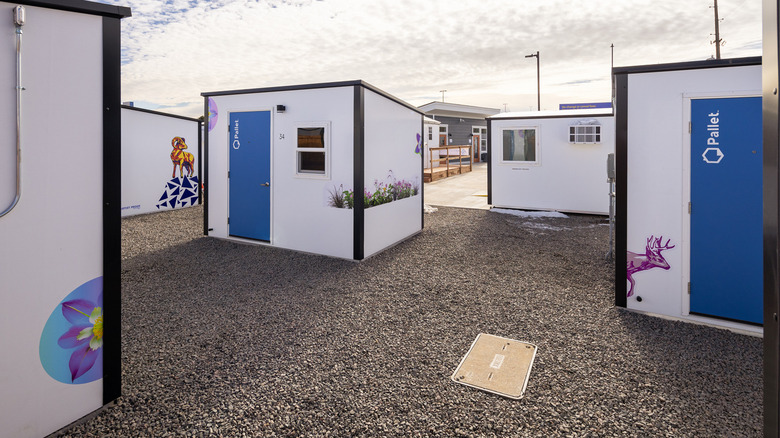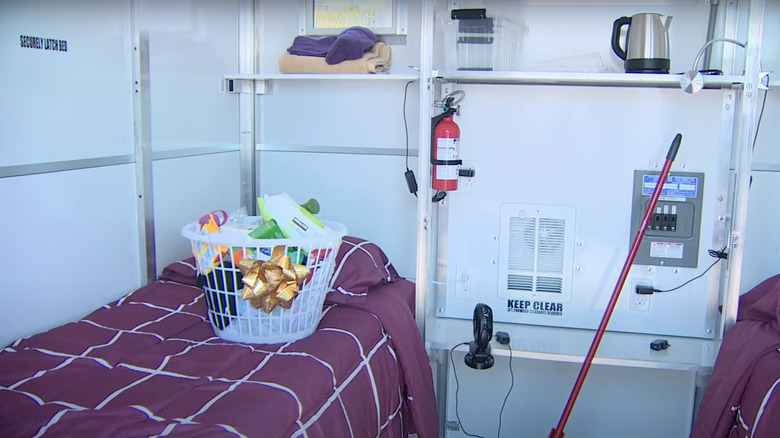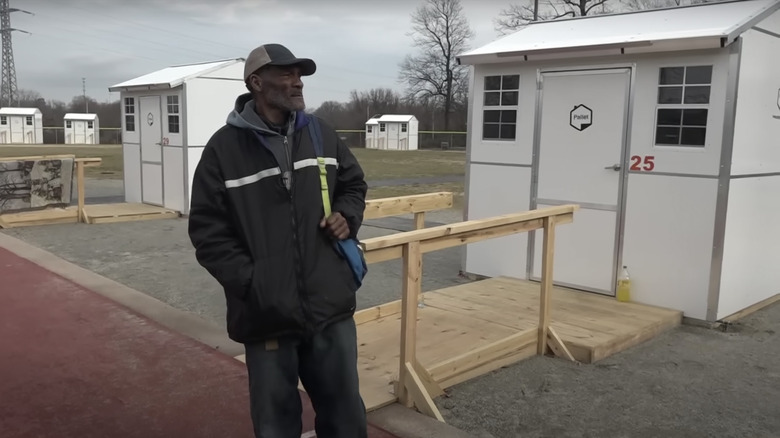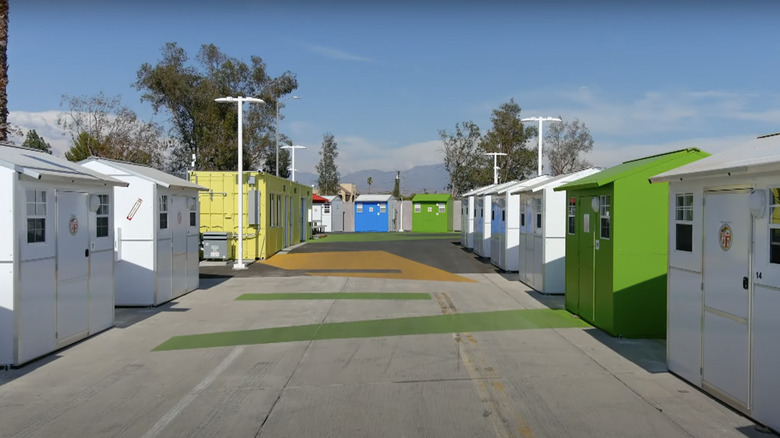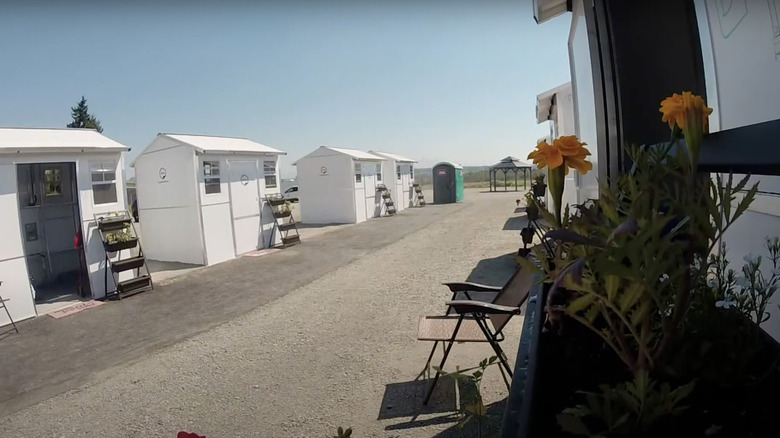What It's Like To Live In A Pallet Home
Minimalism and tiny houses are concepts we are pretty familiar with as smaller living continues to trend. It's no wonder that organizations have taken these ideas and created pallet homes that serve folks who could really use them. A pallet home is often much like it sounds: a small house built with pallets. However, as this initiative continues to develop, the name has come to reference houses that happen to be shipped on pallets but are manufactured with materials that can withstand the elements. Durable materials such as aluminum and reinforced plastics ensure that these homes can last for well over 10 years and serve as many people as possible.
Pallet homes are often utilized as transitional housing for displaced individuals, refugees, veterans, or others who have experienced life-altering events that have left them without a place to live. Amy King, co-founder of the Pallet organization, told LA CityView 35 that her husband originally proposed the idea. "He came up with the concept for Pallet initially, in response to disasters," she said. "If we could create a panelized easy-to-construct house that was lightweight and affordable and cost-effective and all these things, then we could provide shelter and housing to people affordably and quickly." Many organizations work to provide pallet homes for communities in need, and with their quick and easy assembly, people can get housing in a matter of hours. If you or someone you know is interested in one of these communities, here is what you can anticipate when living in a pallet home.
Inside pallet homes
Pallet homes are certainly on the smaller side and are meant to serve as safe and immediate shelter, averaging 64 square feet per house. Some models can be spacious and fit closer to two to four people rather than one, but the more common builds are crafted with sheltering one or two individuals in mind. Although these homes don't offer excessive space, they still provide much-needed amenities. Despite their fast assembly, pallet homes have to pass local safety codes and provide residents with fire alarms, carbon monoxide detectors, and a fire extinguisher. Additionally, the houses are insulated spaces that offer heating in the winter and air conditioning in the summer, as well as electric lighting and outlets.
Typically, these communities assign each pallet home a number so that residents can easily distinguish which house is theirs. Inside, a bed is provided along with storage space for one's belongings. Windows can also be opened and closed, only adding to pallet houses' hominess. One thing that is not included is bathrooms and other hygienic appliances. However, organizations can offer transportation to resource centers that provide showers, restrooms, and laundry services. Outhouses are also offered onsite. Some builds do incorporate these amenities, such as Pallet's S2 Ensuite model, but it is not as common. When a resident is able to move out and into a new home, the organizations sponsoring the community will help clean the unit and prepare it for the next person.
Resident experiences
For residents who stay in pallet homes, their experience is more than shelter and a bed. CEO and co-founder Amy King told LA Cityview 35 that Pallet requires a partnership with service providers like Salvation Army and Hope of the Valley to provide targeted services for individuals, like job and permanent housing searches, in addition to transitional homes. "That is really the magic of how the rehabilitation happens in these sites, right," she said. "The shelter is one thing. It encourages someone to come inside. But the service engagement is what really changes a person's life and helps them move on."
At Pomona Park in Greensboro, North Carolina, current residents in the pallet home community spoke up about their first-hand experience and how it's positively impacted their lives. "To me, it's a blessing. I mean, it's better than sleeping in your car," said a resident who didn't want to disclose his full name or face (via Fox8 WGHP). He went on to explain that he had severe medical issues and six intense surgeries that contributed to him having to live in his car for six months before moving into a pallet home. Joseph Quick is another resident who was unhoused for five years and lived between shelters. "Take a look at my man cave," he directed WFMY News 2. "Got my little shoes lined up. I gotta open the windows sometimes ... It is something until you can do better, you know what I mean?"
Pros and cons of pallet home living
In addition to the enormous benefit of having shelter, pallet communities aim to provide their occupants with comfortable living. The shelters offer the basics of a bed and storage for belongings, and security is available on-site to ensure the safety of residents. Those living in pallet homes have neighbors and friends to share their experiences. Those living in these communities are never alone, whether due to the organizations aiding their rehabilitation or the friendly neighbors they meet along the way.
Although pallet homes have many perks and offer residents incredible support, there are things to consider when applying. Pallet homes do not have plumbing, so bathroom and hygiene needs must be cared for in public resource centers and outhouses. There are not any kitchenettes in these homes, either, meaning outside of dry goods, it's not easy to keep food stored. Being offered a pallet house won't always come with the guarantee of transportation, although organizations help with bus schedules. But most importantly, pallet homes are temporary and cannot be treated as permanent housing. "When we're talking about homelessness, the intent here is not for someone to live here forever," King said. "That's not why we created this. And this is not a way that someone should live forever."
Resources for pallet homes
There are ways to get involved in pallet home communities, whether you are looking to benefit from the organizations helping place individuals in homes or want to donate and contribute to the movement. Those seeking shelter should start by locating the closest programs in their area. With this being a newer initiative, there are fewer pallet home communities available than we would hope, but it's progressing more and more each day. Pallet's website offers a list of cities that have pallet communities, the number of homes in each community, and what organization is helping fund and sponsor the housing. To inquire about getting on the waiting list for a house, contact the organizations listed online and learn about their application process.
For Greensboro, North Carolina, the initiative is called the Doorway Project, and those interested need to go through a referral and intake process. Anyone who is over 60 years of age or has a disability will have the chance of getting bumped up on the waitlist. It is also important to note that pallet homes are small and not family-oriented. For anyone looking to donate, many of the nonprofits and sponsors for these communities take donations on their websites. If you are an organization looking to contribute to the community, search the city's official website.
Alternative housing resources
One major drawback of pallet homes is the limited number of communities available and the even more limited space in those communities. Only 13 states are currently partnering with Pallet specifically, and of those 13, only Washington, Oregon, Colorado, and California have more than one or two communities established. Even in states with several pallet home communities, each location only holds between 10 to 50 shelters, severely limiting the number of people who can be helped at once. Waitlists will be long, and if you or someone you know lives in a state that doesn't partner with Pallet, there are other options.
States and federal agencies often have emergency solutions available to combat homelessness, while some federally funded programs are available in all 50 states. Folks experiencing a housing crisis can utilize hotlines to contact representatives who can help locate resources that fit your situation. Websites for the National Coalition for the Homeless and the U.S. Department of Housing and Urban Development offer essential information and resources nationwide.
